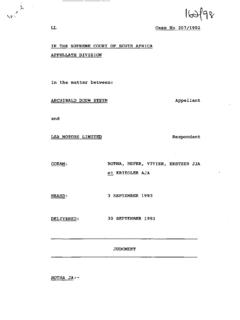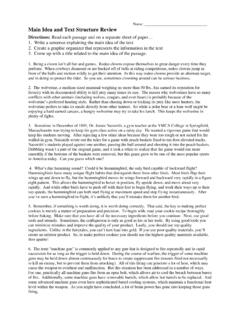Transcription of Section 4 – HAnDicAP SYSteM AnD coURSe RAtinG
1 1 - 2011 HAnDicAP SYSteM and coURSe RatingSection 4 HAnDicAP SYSteM AnD coURSe RAtinGtAble of contentSPagePARt ieXPlAnAtion of coURSe RAtinG SYSteM4 -1 PARt iiHAnDicAP MAnUAl4-3 Section 1 Purpose and Requirements4 -3 Section 2 Definitions4-4 Section 3 The Player4-6 Section 4 Adjusting Hole Scores4-9 Section 5 Scores4 -10 Section 6 Scoring Records4 -12 Section 7 Clean and Place4 -13 Section 8 The HAnDicAP Committee4 -14 Section 9 HAnDicAP Competitions4 -18 Section 10 NZG HAnDicAP Formula4-24 Section 11 HAnDicAP Controls4-25 Section 12 9-Hole Golf4-26 APPenDiX iMethod for Determining Most Improved Player4-27 APPenDiX iiTwilight Tournaments4-281 - 2011 HAnDicAP SYSteM and coURSe RatingPARt i eXPlAnAtion of coURSe RAtinG SYSteMThe New Zealand Golf (NZG) coURSe RAtinG SYSteM was introduced on 1 September 2000, following numerous trials, and the inadequacies of the previous SYSteM .
2 We are indebted to the coURSe raters, of which there are nearly 200, for their voluntary work and dedication to this important aspect of the has a license agreement with the USGA to use both the coURSe RAtinG and HAnDicAP SYSteM , and believes this to be the most advanced and fairest SYSteM available is the objective of NZG to provide a uniform handicapping SYSteM , and the consistency and accuracy of coURSe ratings , bogey ratings and the associated Slope Numbers is vital to achieving should be noted that although RAtinG teams work from January to December, they are assessing the playability of the coURSe when most rounds are played. Here in New Zealand that is autumn, March-May, and spring, simple explanation of the systemThe SYSteM follows a series of assessments and coURSe raters complete a thorough process which takes approximately 3-4 hours per set of tees.
3 There are established standards relative to how far a player hits the ball, and it is from these positions that obstacles are close scrutiny of the SYSteM confirms that the biggest contributor to the difficulty of the coURSe is the overall length, and this is evident in the formula used to calculate the final main formula component is the effective playing length of the coURSe , which is derived from the coURSe s measured length. There are then five factors that are considered, giving a more accurate number that reflects the true playing length of the coURSe . These are: Roll Changes in elevation Wind Forced lay up areas AltitudeThe measured length and the effective playing length adjustments are used to determine a Yardage RAtinG for two categories of player, the scratch golfer and the bogey golfer. The Scratch Yardage RAtinG and the Bogey Yardage RAtinG are the base numbers used in the calculation of the Scratch coURSe RAtinG and Slope is very important that each hole has a block indicating where the hole has been measured from.
4 The blocks should be in realistic places so that tee placement can be both in front of and behind the block. If there are three sets of tees (blue, white and yellow) then there should be three separate blocks indicating where these measurements commence further analysis of the coURSe looks at each hole and the obstacles that affect playing difficulty. There are 10 obstacles being:1. Topography the impact of terrain on play2. Fairway width the difficulty of keeping the ball on the fairway3. Green target size and the difficulty of hitting that green4. Rough & Recoverability covers the difficulty of a shot when the fairway or green has been missed5. Bunkers how they come in to play and the difficulty of recovery6. OB & Extreme Rough the proximity of these areas and how they come in to play7. Water hazards the proximity of these areas and how they come in to play8.
5 Trees based on density, proximity, and the difficulty of recovery9. Greens Surface assesses the difficulty of a green from a putting perspective, and includes the speed and contouring or tilt of each green10. Psychological based on the accumulative effect ratings of the other nine obstacles, there may be a value added in this categoryThe values allocated to the above obstacles are multiplied by various factors giving a final number, which may be a small incremental addition or reduction to the scratch yardage RAtinG . The result is the coURSe final summary will provide three results. 1. The Scratch or coURSe RAtinG is the mark that indicates the playing difficulty of the coURSe for a scratch golfer. 2. The Bogey RAtinG is the mark that indicates the difficulty for the 20 HAnDicAP male player and 24 HAnDicAP female player, and is expressed in a number that reflects these players expected The Slope Number is the mark that indicates the relative difficulty of the coURSe for the bogey player, relative to the scratch player.
6 113 is the average Slope Number. Anything above this and the bogey player will require a little more help relative to the scratch player, and a number less than 113 will mean that the bogey golfer requires less the Slope numberThe Slope Number is a figure derived from the ratings that indicate the difficulty of the coURSe for the two types of player, the scratch and bogey golfer. The difference of the two ratings is multiplied by (men) and (women) to give the Slope - 20114-2 HAnDicAP SYSteM and coURSe RatingNote: It is only relative to the set of tees rated, and cannot be compared with the slope number of other 1: Hamilton Golf Club Blue tees, 6,684 yards coURSe RAtinG Bogey RAtinG Slope Number - x 129 Example 2: Hamilton Golf Club White tees, 6,345 yards coURSe RAtinG Bogey RAtinG Slope Number = x = 130 The white tees are over 500 yards shorter than the blue, which is reflected in the coURSe RAtinG .
7 However for the Slope Number to be higher on the shorter coURSe , the obstacles must be more severe from those tees for the bogey golfer, in comparison to how they rate from the blue is the slope number used for?The Slope Number provides a player with a coURSe HAnDicAP after multiplying a HAnDicAP Index by the Slope Number, then dividing by 113. The Slope Number is also used when putting a player s round in perspective in comparison to all other courses. Once a player has returned a score, the coURSe RAtinG is deducted from the adjusted gross, the difference is multiplied by 113 and then divided by the Slope playing a coURSe that has a high Slope Number, most golfers are going to require some assistance. Take Kauri Cliffs for example, where the Slope Number from the white tees is 138. The scratch player, or low HAnDicAP golfer, can carry the ball the distances required at this coURSe , but it is a far greater challenge for the higher handicapper.
8 At Pauanui Lakes where the Slope Number is 91, the bogey golfer is at a great advantage in comparison with the scratch golfer, as it is a short coURSe with little trouble, and the Slope Number allows for the adjustment required. Examples: Player A has a HAnDicAP Index of , Player B i. On a coURSe with a Slope Number of 113, their coURSe HAnDicAP will remain the same as their HAnDicAP Index. ii. At Kauri Cliffs (white tees, 138) Player A (after rounding) will remain on a coURSe HAnDicAP of 2, ( x 138/113 = ) Player B s coURSe HAnDicAP (after rounding) will be 26, ( x 138/113 = ) iii. At Pauanui Lakes (blue tees 91) Player A will remain on a coURSe HAnDicAP of 2, ( x 91/113 = ) Player B s coURSe HAnDicAP will be 17, ( x 91/113 = )How clubs can help in preparing their coURSe for RAtinG ?There will be some information that RAtinG teams require before they commence their RAtinG .
9 This includes:1. The measurement blocks on the tees easily identifiable and, where possible, a surveying certificate to confirm the measurement is The normal green speed during spring and The height of the The prevailing would also be helpful to have the fairway widths as they are normally, and the green sizes as they are during the main playing is important that a club member with local knowledge on wind, and how each hole can play, joins the RAtinG team (the narrator) as from time to time there will be a query that will require an asked questions regarding coURSe RatingQ How often are courses to be re-rated?A It is important that coURSe ratings are as reflective of the playing difficulty as possible, and there is a guideline for re- RAtinG in the NZG policy. A coURSe where more than 10,000 HAnDicAP cards are submitted annually should be re-rated every three years, and for those returning less every four to five Our coURSe has a slope number of 115, yet a near coURSe has a number of 125, but is shorter and not as difficult.
10 How can this be possible?A You can only compare two different courses by referring to the coURSe RAtinG . From what you describe your coURSe RAtinG will certainly be higher, therefore confirming that your coURSe is the more difficult. The Slope Number refers to the difference in difficulty for the bogey golfer in comparison to the scratch golfer on the set of tees being Why do we not have a summer and winter coURSe RAtinG ?A Courses are rated for peak season conditions, which here in New Zealand are spring and autumn. Our statistics show that 67% of HAnDicAP cards are entered at this time. The SYSteM we have adopted provides one RAtinG , and it is accepted that at times playing conditions may differ in relation to the RAtinG . If the conditions are such that the RAtinG is severely affecting the accuracy of players HAnDicAP indices, then a closed season can be - 2011 4 -3 HAnDicAP SYSteM and coURSe RatingQ It is our Club s belief that our ratings are not correct.






